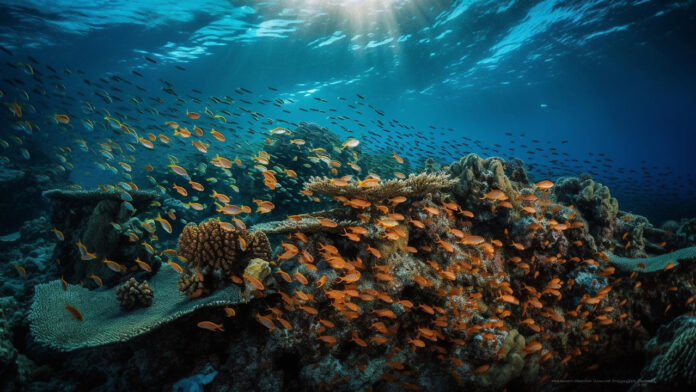The Great Barrier Reef, a marvel of the natural world, stretches over 2,300 kilometers along the northeast coast of Australia. This living masterpiece is not just a coral reef; it’s a thriving ecosystem that supports an incredible diversity of marine life. In this article, we dive deep into the fascinating facts that make the Great Barrier Reef a global treasure, exploring its vibrant biodiversity, the challenges it faces, and the ongoing conservation efforts to protect this underwater wonder.
A Colossal Coral Ecosystem
Size and Magnificence: The Great Barrier Reef is the world’s largest coral reef system, covering an area of approximately 344,400 square kilometers. Its sheer size makes it visible from space, showcasing the enormity of this underwater spectacle.
Diverse Coral Species: Within its expansive boundaries, the reef is home to more than 2,900 individual coral reefs and 900 islands. It hosts an astonishing variety of coral species, each contributing to the intricate tapestry of colors and shapes that define the reef.
Marine Biodiversity Extravaganza
Multitude of Marine Species: The Great Barrier Reef is a biodiversity hotspot, sheltering a staggering array of marine life. Over 1,500 fish species, 400 coral species, and countless invertebrates call this reef system home, creating a vibrant and interconnected ecosystem.
Megafauna Marvels: From the majestic humpback whales to the gentle giant, the whale shark, the Great Barrier Reef attracts a diverse range of megafauna. Dolphins, turtles, and various shark species also contribute to the reef’s rich biodiversity.
Coral Bleaching and Environmental Challenges
Coral Bleaching Phenomenon: One of the critical challenges facing the Great Barrier Reef is coral bleaching. Elevated sea temperatures, exacerbated by climate change, can stress the corals, leading to the expulsion of their symbiotic algae and causing the corals to turn white—a phenomenon known as coral bleaching.
Impact of Climate Change: The rise in sea temperatures, ocean acidification, and extreme weather events pose significant threats to the reef. Climate change-induced stressors can compromise the health of coral communities and disrupt the delicate balance of the ecosystem.
Conservation Efforts and Protection
UNESCO World Heritage Status: Recognizing its global significance, the Great Barrier Reef was designated a UNESCO World Heritage Site in 1981. This status underscores the reef’s importance for humanity and emphasizes the need for international collaboration in its preservation.
Great Barrier Reef Marine Park Authority: The Great Barrier Reef Marine Park Authority (GBRMPA) plays a crucial role in managing and protecting the reef. Through zoning, regulations, and conservation programs, GBRMPA strives to balance human use and environmental sustainability.
Underwater Wonders and Dive Tourism
Scuba Diving and Snorkeling Adventures: The Great Barrier Reef offers unparalleled opportunities for scuba diving and snorkeling. Exploring the vibrant coral formations and encountering diverse marine life create unforgettable experiences for underwater enthusiasts.
Dive Sites: From the iconic Ribbon Reefs to the mesmerizing Cod Hole, the Great Barrier Reef boasts a plethora of renowned dive sites. Each site presents unique underwater landscapes, from coral gardens to underwater canyons, attracting divers from around the world.
Sustainable Tourism Initiatives
Balancing Tourism and Conservation: The delicate balance between tourism and conservation is a key consideration for the Great Barrier Reef. Sustainable tourism initiatives aim to minimize environmental impact, raise awareness, and contribute to the long-term health of the reef.
Citizen Science Participation: Citizen science programs engage tourists in reef monitoring activities. These initiatives empower visitors to contribute valuable data on coral health, marine species, and environmental conditions, fostering a sense of stewardship.
Reef Resilience and Future Outlook
Natural Resilience of Coral Reefs: Coral reefs, including the Great Barrier Reef, possess a remarkable capacity for resilience. Natural processes such as coral recruitment, regrowth, and adaptation contribute to the ecosystem’s ability to recover from disturbances.
Research and Innovation: Ongoing research and innovative solutions, such as coral breeding programs and reef restoration projects, play a crucial role in enhancing the reef’s resilience. Scientists and conservationists are exploring ways to assist the recovery of damaged coral areas.
Conclusion: A Call to Protect Our Ocean Jewel
In conclusion, the Great Barrier Reef stands as a testament to the awe-inspiring beauty and ecological significance of our planet’s underwater realms. As we marvel at the intricate ecosystems and vibrant marine life, it becomes imperative to recognize the environmental challenges facing this natural wonder. Through global cooperation, sustainable practices, and ongoing conservation efforts, we can ensure that the Great Barrier Reef continues to thrive for generations to come—a living testament to the resilience and fragility of our interconnected world.

